While you can always simply mount numbers next to your front door to indicate your address, a custom address plaque post is always a more memorable and personal touch for your home. But before diving into the construction process, it’s important to understand what the project entails. In this guide, we’ll walk you through the process of building and installing your own address plaque post using affordable materials and simple techniques for a successful DIY project.
Preparing Your Address Plaque Project
Building an address plaque post is a relatively straightforward DIY task that can be completed in a day, but it does require some basic tools and skills.
Skill Level and Time Requirements
This project is possible for beginners with basic DIY experience who have good cutting and assembly skills. Depending on how you want your address plaque to look when it’s finished, this project can likely be completed in about 4 hours from start to finish. This time estimate includes measuring, cutting, assembling, and installing the post.
Materials List
Depending on the materials you want, prices will vary, but there are some essential items you’ll need. Here’s a breakdown of the main materials you’ll need to buy:
- Mayne polymer mailbox post
- Cambridge ornate address plaque
- Wirral bracket
- Standard premier ball ornament
- Mayne no-dig ground screw
Additional items and materials you’ll need include:
- Pressure-treated 4×4 post
- 1×6 cellular PVC board
- Exterior screws
- Polyurethane construction adhesive
- Paint (if desired)
Tools for this project include:
- Tape measure
- Miter saw
- Drill/driver with various bits
- Caulk gun
- Lag-screw driver bit
Choosing the Right Location
Pick a spot that is easily seen by visitors and delivery drivers. Before installation, you should check with local services to check for underground utilities in your chosen spot.
Building the Post
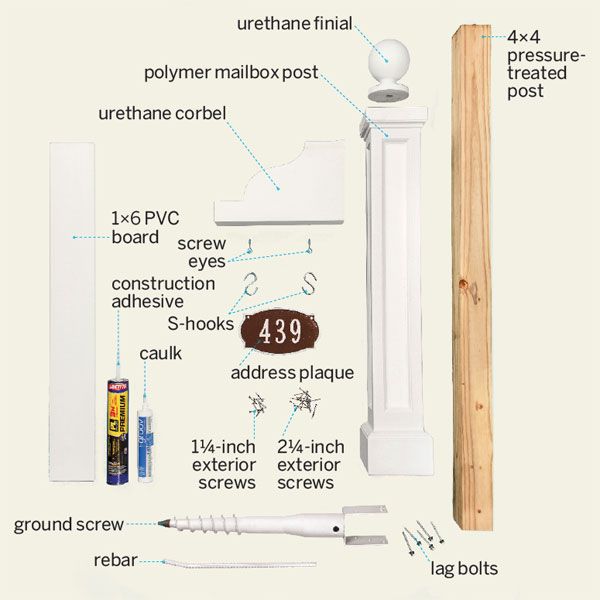
After gathering all of your supplies and tools, you’ll first want to construct the post and main arm that will hold your address plaque.
Measuring and Cutting the PVC Board
To create the arm for the plaque, you’ll need to cut the PVC board to size:
- Measure the short and long sides of your corbel.
- Add 3/4 inch to the short dimension and mark this length on the PVC board.
- Add 1 1/2 inches to the corbel’s long dimension and note this measurement.
- Using a miter saw, make a 30-degree left bevel cut at the mark on the PVC board.
- On the remaining board, measure from the slope’s short point and mark the longer length you noted earlier.
- Make a straight cut at this mark.
- You should now have two boards: one long and one short, each beveled at one end.

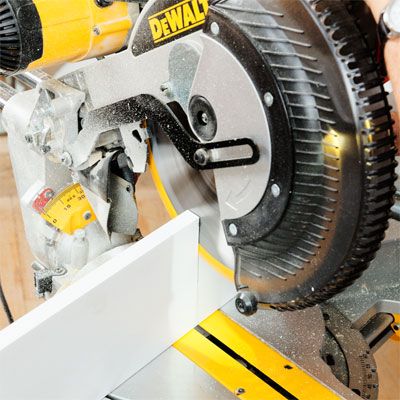
Assembling the Corbel Structure
With your cut pieces ready, it’s time to assemble the corbel structure:
- Arrange the boards in an L shape, with the square end of the short board butted against the face of the longboard, checking the angles facing the inside of the L.
- Drill pilot holes and fasten the longboard to the shortboard using three 2 1/4-inch exterior screws.
- Center the corbel on the L-shaped structure and trace its edges.
- Apply a heavy bead of polyurethane construction adhesive inside the traced lines.
- Set the corbel in place, pressing it into the adhesive for good coverage.

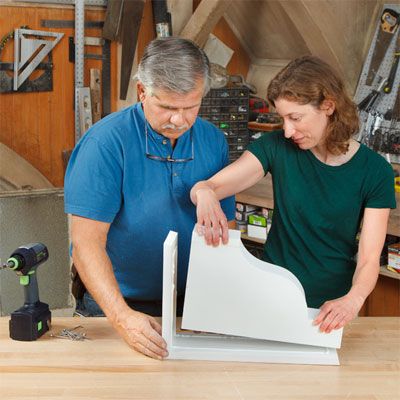
Attaching the Address Plaque
With the post and corbel assembly complete, it’s time to prepare for and attach the address plaque. This step will secure your house numbers to the plaque display.
To center and level your address plaque, you’ll want to follow these steps:
- Place the post and corbel with the longboard facing up.
- Center the plaque on the board.
- Measure the distance from the plaque’s right hole to the board’s left edge and then from the left hole to the right edge.
- Adjust the plaque until these measurements are equal.
- Mark the hole locations and drill pilot holes for screw eyes.
- Twist in the screw eyes by hand.

Now that the assembly is prepared, it’s time to attach it to the main post:
- Dry-fit the assembly on the post and mark where its top and bottom edges fall.
- Apply adhesive between these marks on the post.
- Place the assembly within the marks and press it into place.
- Drive 1 1/4-inch screws through the countersinks in the assembly and into the side of the post.
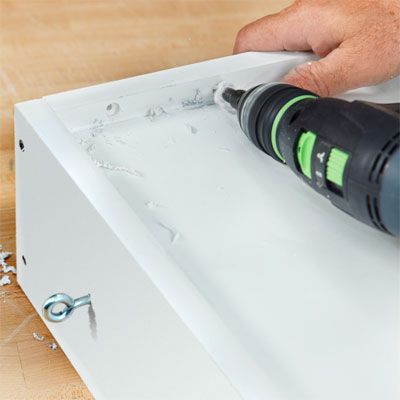
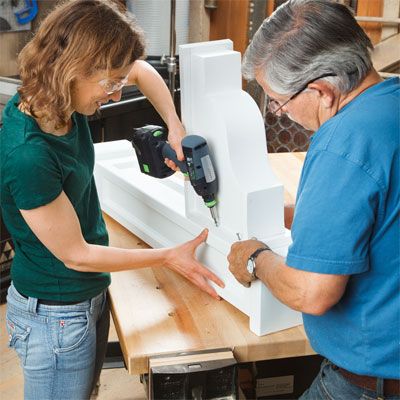
Installing the Finished Plaque Post
With your address plaque post assembled, the final step is installation. This process involves securing the post in the ground and mounting the pose securely. A ground screw provides a solid foundation for your address plaque without having to use concrete:
- Choose a safe spot for your post, away from underground utilities.
- Twist the ground screw into place using a piece of rebar for leverage.
- Cut your pressure-treated 4×4 post to the appropriate length.
- Attach the 4×4 to the ground screw using lag bolts.
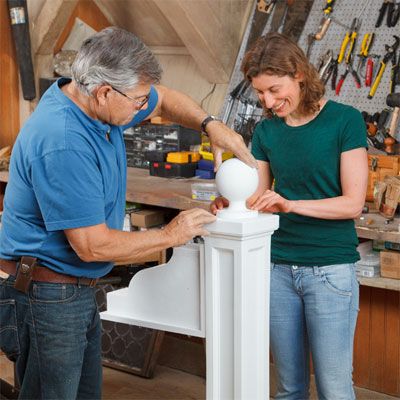
To complete the installation, slide your finished post over the 4×4. Drive a 2 1/4-inch screw through the top of the corbel assembly and into the 4×4 for more stability. Lastly, you’ll hang your address plaque using S-hooks.
Customizing Your Address Plaque Post
One of the benefits of building your own address plaque post is the ability to customize it how you’d like. This section will explore ways to make your post unique and complementary to your home’s style.
Adding Decorative Elements
Personalize your post with decorative touches, such as attaching a decorative finial or ornament to the top of the post using an adhesive. You could also consider installing solar-powered lights to illuminate your address at night or a small planter box for seasonal flowers at the base of the post.
Painting and Finishing Touches
To protect your post and match it to your home’s exterior, fill any seams or screw holes with paintable caulk and apply a coat of high-quality exterior paint that won’t be affected by outdoor conditions. You can also add a clear sealant for extra paint and structural protection.
Maintenance and Care Tips for Your Address Plaque Post
Regular maintenance will keep your address plaque post looking great despite being faced with different weather conditions and outdoor elements.
To shield your post from the outdoors, apply a fresh coat of paint or sealant every two to three years. Check for any cracks or separations annually and reseal areas as needed. Look for proper drainage around the base of the post to prevent any water damage. These steps will help protect your address plaque post for long-term durability.
Washing the post and plaque with mild soap and water twice a year will maintain the appearance of your address plaque. Remove any debris or cobwebs that accumulate around the post, and touch up scratches or chips in the paint as you notice them.
Alternative Address Plaque Mounting Options
While a freestanding post is a common choice, there are other ways to display an address plaque. These alternatives can be useful if you have limited yard space or prefer a different look.
Attaching to Vinyl Siding
To mount an address plaque, use a mounting bracket designed for vinyl siding. Locate the studs behind the siding for a more secure attachment. Most importantly, apply exterior caulk around the mounting holes to prevent water from getting inside your home’s siding.
Securing to Brick Surfaces
For brick homes, you can use a masonry bit to drill pilot holes in the mortar joints, not the bricks themselves. Insert plastic anchors into the holes and attach the plaque or mounting bracket using masonry screws.

